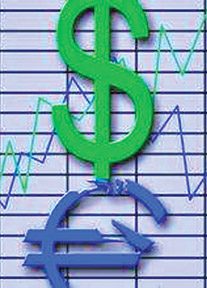Exchange rate movements and its impact on the economy
The exchange rate movements and exchange rate regimes assume very
high priority in the management of macro-economic policies in the
economy.
The exchange rate movements has direct impact on the export
competitiveness, cost of imported raw material and consumer products,
cost of serving foreign borrowings, services sectors such as tourism,
BPO, foreign direct investments, the general inflation, the price
stability, general employment and income of the economy.
 The business community is more concerned about the volatility of
exchange rates, as high volatile exchange rates would erode business
competitiveness and the long-term business relations with both buyers
and the sellers overseas, the Research and Policy Advocacy Unit of
Federation of Chambers of Commerce and Industry of Sri Lanka (FCCISL)
said. The business community is more concerned about the volatility of
exchange rates, as high volatile exchange rates would erode business
competitiveness and the long-term business relations with both buyers
and the sellers overseas, the Research and Policy Advocacy Unit of
Federation of Chambers of Commerce and Industry of Sri Lanka (FCCISL)
said.
Fractional or slight changes in the movement of exchange rates will
have profound and occasionally even disproportionate impact on the
economy at large. The monetary policy formulators therefore naturally
focus heavily on maintaining stability in the domestic foreign exchange
market.
International trade transactions in Sri Lanka are largely carried out
in US dollars. Therefore, the external value of the Sri Lankan Rupee in
terms of the US Dollar denotes very high significance over other freely
convertible foreign currencies. Foreign exchange transactions for
international trade are being predominately carried out by licensed
commercial banks.
However, approved foreign exchange dealers in the private sector also
play an important role particularly for foreign exchange transactions
pertaining to non-trade domain.
In the recent past, the Sri Lankan Rupee has been gradually
appreciating vis-…-vis major foreign currencies mainly due to the US
Dollar loosing its value steadily in international financial markets
recently.
Increasing foreign exchange inflows from the services sector,
workers’ remittances and financial flows from the international
sovereign bond issues and gradual increase of export revenue are some of
the other reasons attributed to the appreciation of the Rupee.
The Central Bank of Sri Lanka intervenes regularly in the market to
mitigate excessive volatility in the exchange rate and to ensure
competitiveness of exports would not be eroded due to undue appreciation
of the Rupee.
According to the Central Bank of Sri Lanka, during 2010 both Nominal
Effective Exchange Rate (NEER) and Real Effective Exchange Rate (REER)
appreciated against the entire major currencies except the Japanese Yen
and Indian Rupee. It is observed that Sri Lanka maintains a managed
exchange rate policy. In other words, the market forces do not solely
determine the external value of local currency.
|

Substantial number of workers’ remittances transactions are
still conducted outside the banking system via the Hawala
System, depriving valuable foreign exchange to the country |
While market forces are largely reflected in the value of the
exchange rates, monetary policy also intervenes to avoid excessive
volatility of the exchange rate. In this process, one of the soft
instruments being practised by the Central Bank of Sri Lanka is daily
publishing of the Approximate Indicator Exchange Rate based on the
previous day’s market weighted average rates for the US Dollar.
Although this is the average rate for the US Dollar, the different
commercial banks quote different buying and selling rates with variant
degrees of margins between the buying and selling rates.
Understandably, as a general rule no commercial bank buys foreign
exchange higher than the buying rates quoted or sells below the daily
selling rate indicated by the Central Bank.
However, some commercial banks depending on the quantum of the
turnover of foreign exchange dealing carried out by the bank and the
amount tendered or purchased makes certain exceptions to this rule.
The approved exchange dealers prepare to offer higher rates of buying
than the Central Bank indicative rates depending on the quantum of
foreign exchange tenders, denomination of the currencies and the
bargaining power of the customers. High valued foreign currencies always
maintain high margin of difference between the selling and buying price.
The variation of the margin though not very high yet reflected
noteworthy differences when it comes to the question of large-scale
international trade transactions. According to representations made by
the Sri Lankan entrepreneurs engaged in international trade,
transactions, this variation with a high margin than the margin
stipulated by the Central Bank erode their competitiveness in the
international market and the cost of imported raw materials, inputs and
consumer products.
Substantial number of workers’ remittances transactions are still
conducted outside the banking system via the Hawala System, depriving
valuable foreign exchange to the country due to the bottlenecks observed
at the point of sending money and even at the point of receiving money
in Sri Lanka.
If this problem can be addressed effectively, the current workers
remittances of foreign exchange could be further enhanced to strengthen
international reserves of the country, the Research and Policy Advocacy
Unit of FCCISL said.
CdeS |



